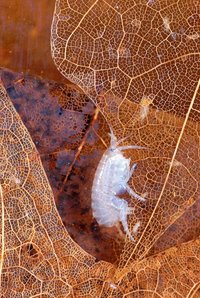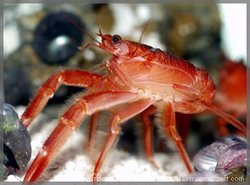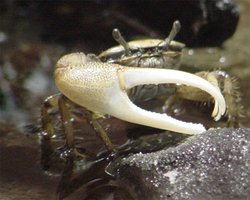Crustacean
|
|
| Crustaceans | ||||||
|---|---|---|---|---|---|---|
 Hyalella azteca | ||||||
| Scientific classification | ||||||
| ||||||
| Classes | ||||||
|
The crustaceans (Crustacea) are a large group of arthropods (55,000 species), usually treated as a subphylum. They include various familiar animals, such as lobsters, crabs, shrimp and barnacles. They are variously found in marine and freshwater, with a few terrestrial members (such as woodlice).
The scientific study of crustaceans is known as carcinology.
| Contents |
Structure of crustaceans
Crustaceans have three distinct body parts: head, thorax, and abdomen (or pleon), although the head and thorax may fuse to form a cephalothorax. They have two pairs of antennae on the head, compound eyes, three pairs of mouthparts and a telson. Smaller crustaceans respire through their body surface by diffusion and larger crustaceans respire with gills. Crustaceans typically have a thick carapace on the dorsal side of their body. Their appendages are typically biramous, including the second pair of antennae (but not the first).
Reproduction
Most crustaceans have separate sexes and are distinguished by appendages on the abdomen called swimmerets or, more technically, pleopods. The first (and sometimes the second) pair of pleopods are larger on the male than on the female. Terrestrial crabs (such as the Christmas Island red crab) mate seasonally and return to the sea to release the eggs. Crabs' eggs are retained by the females until they hatch into free-swimming larvae.Taxonomy
The formal classification of crustaceans varies somewhat. In general, because of the large number of species, taxonomists have made extensive use of subordinate taxonomic categories (suborders, superfamilies and so forth), and the status of different groupings is frequently controversial; this can make taxonomic references hard to follow. Evolutionary relationships between the different groups are not entirely clear, making the exact definition of larger groups difficult.
Some authorities have treated the entire group of crustaceans as a class, in which case the classes escribed in the taxonomic table are treated as subclasses. Other authors omit some or all of the classes listed here, in which case some of the groups given here as subclasses are promoted to full class rank. This listings given at the end of this article and in the summary table at the right are those recommended by ITIS, and as such probably represent a consensus of modern opinion. However, good practice in describing crustaceans must clearly be to include descriptions at several taxonomic levels, to ensure that readers can link the information to others' schemes. Less formally, we can state that the most important groups of crustaceans are barnacles (infraorder Cirripedia), branchiopods, copepods and Malacostraca (crabs, lobsters, shrimps and krill). There are around 1,220 barnacle species, 1,000 branchiopods, 13,000 copepods, and 30,000 Malacostraca.Geological history
Although crustaceans are rarer as fossils than trilobites are, a number of different types of crustaceans are common in the rocks of the Cretaceous period as well as those of the Caenozoic era. Most of the smaller crustaceans, such as shrimp, have an exoskeleton which is somewhat delicate and for this reason their fossil record is incomplete. However, crustaceans such as crabs and lobsters have a thicker exoskeleton which is reinforced with calcium carbonate and so their fossil record is much better. The fossil record of barnacles is scarce and little is known of their history prior to the Mesozoic era. Well preserved specimens are known from the rocks of the Cretaceous period and the Caenozoic era.
The most well known crustaceans, the malacostraca (crabs, lobsters, crayfish, shrimp), although widespread today are only found sporadically as fossils. Most of the known fossil crabs are of forms which lived on the sea-floor or in a reef environment. In rocks such as the Gault clay from the Cretaceous period and the London clay from the Eocene period in England fossil crabs may be found. The 'Lobster Bed' of the Greensand formation from the Cretaceous period which occurs at Atherfield on the Isle of Wight in England contains many well preserved examples of the small glypheoid lobster Mecochirus magna. The lithographic limestones from the Jurassic period of Solnhofen in Germany have long been famed for the many exceptionally preserved crab, lobster and shrimp fossils they have yielded (such as Aeger, Eryon, and Pseudastacus).
Animal Videos
- Animal Videos (http://classroomclipart.com/clipart/Videos/Animals.htm)
- Marine Animal Videos (http://classroomclipart.com/clipart/Videos/Animals/Marine_Animals.htm)
- Mammal Videos (http://classroomclipart.com/clipart/Videos/Animals/Mammals.htm)
- Amphibian and Reptile Videos (http://classroomclipart.com/clipart/Videos/Animals/Amphibians_and_Reptiles.htm)
Clipart and Animal Clipart & Pictures
- Clipart (http://classroomclipart.com/clipart/Clipart.htm)
- Animal Clipart (http://classroomclipart.com/clipart/Clipart/Animals.htm)
- Animal Animated Clipart (http://classroomclipart.com/clipart/Animations/Animals.htm)
- Pictures of Animals (http://classroomclipart.com/clipart/Animals.htm)



